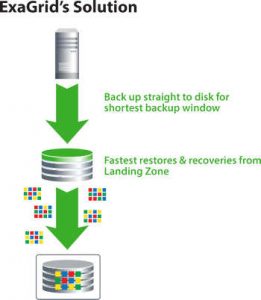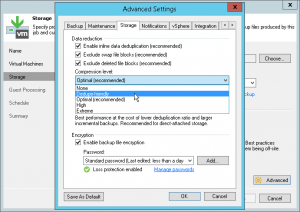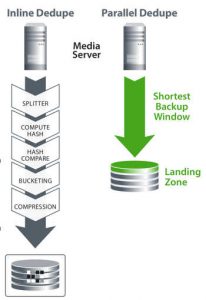ExaGrid Enhances Data De-Dupe Software With V.5.2.2
Achieving ratio of 20:1 on average and including support of Veeam VM backup data, changed block tracking and incrementals forever, in addition to supporting Windows Active Directory and Veritas NetBackup Accelerator
This is a Press Release edited by StorageNewsletter.com on August 16, 2019 at 2:50 pmExaGrid Systems, Inc. announced version 5.2.2 of its software which offers enhancements.
The company has always achieved a deduplication ratio of 20:1 on average along with the majority of the market share backup applications. The firm has taken its deduplication algorithm to new heights for Veeam Software, Inc.‘s VM backup data, changed block tracking (CBT) and incrementals forever, in addition to supporting Windows Active Directory and Veritas Technologies LLC‘s NetBackup Accelerator.
Features include:
-
Improved data deduplication for Veeam Software
-
Improved data deduplication for CBT and incremental backups
-
Ability to further deduplicate Commvault deduplicated data
-
Support of Windows Active Directory
-
Support of Veritas NetBackup Accelerator
Improved data deduplication for Veeam software
Veeam dedupe friendly
Click to enlarge
Veeam Software is an ExaGrid alliance and technology partner. The firm’s deduplication works with and allows Veeam deduplication and Veeam ‘dedupe friendly’ compression to be enabled as a best practice.
The combination of Veeam’s deduplication and ‘dedupe friendly’ compression, along with the company’s deduplication can now achieve a combined deduplication ratio of up to 14:1 for VM backups. The firm has always deduplicated Veeam data, however, it has improved its algorithms to offer a higher deduplication ratio.
The company is a solution that further deduplicates Veeam deduplicated data as well as stores the most recent backup in the Veeam native format for the fastest VM boots available. Veeam can boot a VM from ExaGrid in seconds to minutes versus hours for deduplication appliances such as Dell EMC Data Domain that only store deduplicated data, which requires data rehydration for each request. The company stores long-term deduplicated retention data in a repository, which is separate from the Landing Zone for storage efficiency.
Improved data deduplication for CBT and incremental backups
The firm’s deduplication algorithm improves deduplication ratios over its previous version for backup applications that use CBT or incremental backups. The company supports 25+ backup applications and utilities – the majority of which utilize CBT to make backups more efficient.
Ability to further deduplicate Commvault deduplicated data
The company allows Commvault Systems, Inc.‘s customers to keep deduplication enabled and use the firm’s target storage. It will further deduplicate the Commvault deduplicated data and will improve the deduplication ratio by a factor of 3X up to a combined deduplication ratio of 20:1. With Commvault deduplication, DASH fulls and DASH copies can be enabled for backups and retention management.
The company’s software is cost-effective for Commvault customers who keep weekly, monthly, and yearly backup retention copies. The firm is far less expensive than low-cost disk, as ExaGrid uses far less disk by further deduplicating the Commvault deduplicated data. In addition, the vendor brings linear scalability (scale-out architecture) to allow customers to add appliances as data grows. This approach of adding compute with capacity keeps the backup window fixed in length as data grows.
Support of Windows Active Directory
The company’s GUI was designed with simplicity. To simplify user experience, Windows Active Directory domain credentials can now be used to control access to the firm’s management interface, providing authentication and authorization to the web GUI. This allows IT staff to access the web-based management interface and, in addition, target share access control for CIFS or the Veeam Data Mover.
Support of Veritas NetBackup Accelerator
Veritas’ NetBackup Accelerator technology shortens backup windows by sending only changes for both incremental and accelerated full backups, synthesizing the full backup from previous changes using the OST interface. The company can take in and deduplicate NetBackup Accelerator data and, in addition, the solution reconstitutes the accelerated backup into its Landing Zone so that the ExaGrid system is ready to quickly restore data, as well as provide instant VM boots and fast offsite tape copies-a unique and exclusive feature. In contrast, all inline deduplication appliances only store deduplicated data. When a restore, VM boot, tape copy, etc. is requested, a lengthy data rehydration process must occur.
“ExaGrid’s newest features further differentiate ExaGrid from its competition,” said Bill Andrews, president and CEO, ExaGrid. “We continue to innovate and push the envelope on deduplication efficiency, backup performance, restore performance, and linear scalability to drive up productivity while driving down cost.“
Solves challenges of traditional backup appliances
The company offers an approach to backup storage for long-term retention environments. It realized that simply adding inline deduplication into backup applications or scale-up storage appliances, while reducing the cost of backup storage, also breaks the backup performance, restore performance, and scalability. Deduplication is compute intensive and when performed during the backup window, it will slow backups down. Other backup appliances store only deduplicated data, causing restore requests, VM boots, offsite tape copies, etc. to take hours, because the data needs to be rehydrated.
The company’s software has solved the challenges of using traditional backup storage systems, which use inline deduplication and scale-up architecture. The firm offers a zone-level deduplication that uses similarity detection versus exact block matching, and couples its deduplication approach with an architecture built for backup deduplication storage. Its Landing Zone allows backups to write directly to disk without being deduplicated, which is 3X faster than inline deduplication. The most recent backups are stored in an undeduplicated native backup format ready to be restored, booted, copied, etc. as there is no data rehydration process. A scale-out storage architecture is used in order to add compute with capacity, resulting in a fixed-length backup window as data grows, the elimination of expensive and disruptive forklift upgrades, as well the elimination of forced product obsolescence.

















 Subscribe to our free daily newsletter
Subscribe to our free daily newsletter

